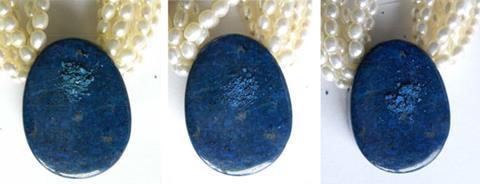Camille Pissarro’s The Côte des Bœufs, Claude Monet’s Gare Saint-Lazare and Pierre-Auguste Renoir’s Les Parapluies all have one chemical constituent in common: synthetic ultramarine. This famous blue pigment dates back to the early 19th century, but its synthesis has always been shrouded in secrecy. UK chemists have been working to uncover the recipe, which could help in art restoration and identifying forgeries.
Ultramarine has always held an air of mystique. Its natural occurrence in the mineral lazurite is so rare that artists used it only for depictions of their most important religious subjects, such as the robes of the Virgin Mary or Saint Peter. In 1824, however, the Society for the Encouragement of National Industry, a French society promoting technological advance, offered a prize to anyone who could make the pigment for less than 300 francs per kilo. That prize went to the French chemist Jean Baptiste Guimet four years later, and several others went on to develop their own versions.
Got the blues
Synthetic ultramarine became widely available to artists but details of its preparation remained secret. Even written versions lacked vital information such as temperatures and preparation times. To this day, says Ian Hamerton at the University of Surrey in the UK, companies protect their modern versions of synthetic ultramarine with patents.

Hamerton and his colleague Lauren Tedaldi, together with art scientist Nicholas Eastaugh at Art Access and Research in London, collated original recipes of synthetic ultramarine to see if it was possible to recreate a historically accurate version. The process involved ‘a lot of trial and error’, says Hamerton, in interpreting vague statements – such as ‘cherry red flame’ in place of a well-defined temperature.
After honing the recipe, the researchers demonstrated that their ultramarine was the same as a historical sample, using spectroscopic analysis to avoid the subjectivity inherent in human perception. The recipe itself is described in detail in the researchers’ paper, but it isn’t straightforward – at one point, sulfuric acid must be liberated at 500°C.
Art historian Cathleen Hoeniger at Queen’s University in Ontario, Canada, thinks the study could help art conservators, who sometimes simulate the circumstances of a painting’s creation in order to understand it in greater depth. ‘It’s instructive to see how imprecise the 19th century recipes are, and how difficult it is to reproduce their procedure and results,’ she says. ‘Historians might assume that all they need to do is follow the traditional recipe, without realising how fraught such an exercise could be.’
Eastaugh agrees. ‘If you want to see how Van Gogh or Monet could paint the way they did, then you need to do these kinds of studies,’ he says. ‘If you want to protect our cultural heritage, work out why it is falling apart and what to do about it, then you need information from investigations like this. If you want to catch the next multimillionaire art forger, then you need such research to point the way.’
References
I Hamerton, L Tedaldi and N Eastaugh, PLoS ONE, 2013, 8, DOI: 10.1371/journal.pone.0050364






No comments yet